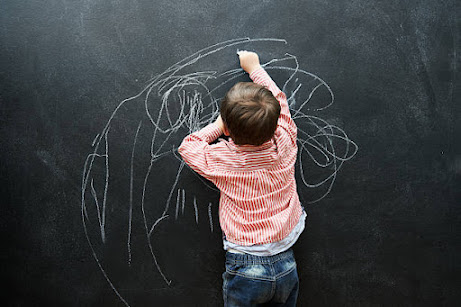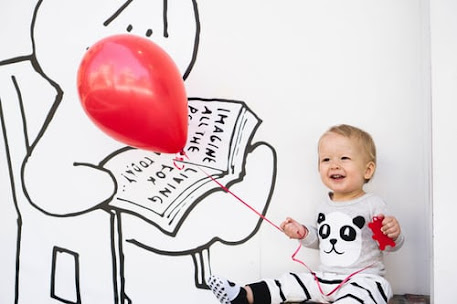15 Easy activities to build the proximal stability in children
This phrase basically means that the stability at the proximal structures of our body (the parts that are closest to the center of our body)– like our core muscles, muscles of our shoulders & the hips is utmost essential in order to have proper functioning and mobility in distal structures – like our legs and arms.
How does proximal stability develop?
Proximal stability starts developing from early childhood & are essential for a child to achieve his gross motor milestones.
Stability first develops in the head and trunk. Once a child has established a stable base, he starts to roll over, to sit up, and eventually reach with his arms, pull himself up, stand up, and walk.
A child cannot accomplish all of this until the base is strong and stable.
Does proximal stability affect handwriting skills?
Having a good proximal stability is one of the foundational skills for handwriting.
If a child doesn't have good proximal stability, he/she struggles with handwriting issues.
When the large muscles of the shoulder girdle & the trunk are strong & hold steady, that allows free movements for the smaller muscles of the arms & hand, thus affecting a child's ability to hold a pencil & to write.
What are the difficulties if a child has poor proximal stability?
If a child has poor proximal stability, he/she might have difficulties with:-
⏩Sitting at a place to finish his task
⏩Hands are wobbly while lifting something up, which is usually easy for his age
⏩Frequently dropping objects while carrying them.
⏩Holding a pencil in a proper functional grasp
⏩Putting the right amount of pressure to write is difficult- the writing may be too light or too dark
⏩Illegible writing
⏩Any fine motor task is quite difficult for the child- like craft activities, coloring within the lines, scissor skills, buttoning his shirt, or eating with a spoon.
Find out more about what are fine motor skills & some simple activities to build fine motor skills in children 👇
(a must-read)
https://abhipsaot.blogspot.com/2021/07/you-must-have-heard-lot-about-fine.html
If a child has a weak core & shoulder girdle muscles are weak & a child's gross motor & fine motor play skills are affected. Even his daily tasks need huge amounts of effort, are extremely tiring and the results are usually lousy.
Proximal stability is a basic foundational skill for writing. But, there are some other factors also that must develop along with proximal stability before a child is ready to start writing.
Find out how to develop a child's prewriting skills in👇
https://abhipsaot.blogspot.com/2021/07/pre-writing-skills.html
What can we do to build proximal stability in children to help with handwriting skills?
Core strength is essential for our everyday activities. Here, I will be listing some activities that you can easily practice at home to build proximal stability in children. These activities are simple, fun & will help your child with his handwriting skills.
➽ Rolling activity
Rollover from one end of a mat to the other end with some meaningful activity like fixing puzzles can be great to build proximal stability.
➽ Rocking in Quadruped
Ask your child to be on his hands & knees (quadruped) and rock back & forth.
You can make it a game like put a toy on his back that he has to move by rocking back & forth. Children will love when you play with them in some creative way.😃
➽ Lift up your arm in the quadruped
➧In the quadruped position, lift one arm up to give you a high five, or touch a toy, put it down, and lift up the other arm.
➧For younger kids, reaching out for a toy can be given.
➧He can make a fist, with one hand forward, and sway a little- pretending to be a boat rocking in the ocean.😃
➧To make it even more fun and effective, you can ask him to throw some balls inside a bucket in this position.
➽ I am Superman
➧Lie on your belly and try to lift up both your arms, chest & legs pretending to fly like superman.
➧Make it more fun & challenging by asking to throw a ball at you in that position.
➧If a child cannot maintain this position, he can start by lifting up both his arms & chest with legs touching the ground.
➽ Wall push-ups
➽ Commando crawling
This is an excellent activity to build proximal stability. You can make it meaningful by giving your child some puzzles to complete with the activity.
➽ Catch & throw a large ball
This is a fun game that all children love to play & it has multiple benefits!
You can make it more fun by adding some variations like-
➧Catch & throw the ball counting alternatively.
➧Catch & throw a ball at you using one hand or both hands
➧If you use slightly heavier balls appropriate to your child's age & strength, that will be very effective for proximal stability.
You can make it more or less challenging by increasing or decreasing the distance at which you stand (kid needs to use more force to throw if the distance is more & vice versa).
This is a very enjoyable play activity that has multiple benefits.😃
You can simply hang a small ball from a rope and ask your child to hit it with a bat.
You can use your creativity to make different games.
Make sure your child can lift the objects & they are not too heavy for them.
➧You can ask your child to lift up bottles of water from the floor and put them on the table one by one.
➧Carrying a basket of fruits/vegetables from the kitchen to the freeze.
➧Carrying a small pile of books/copies from one room to the other.
➽ Push & pull heavy objects
Kids love to push & pull different objects & it's a great activity to build proximal stability.
➧Push & pull stools/chairs,etc.
➧Push & pull buckets with wet clothes.
➧Playing a game of "tug-of-war".
➽ Working on a vertical surface
➧Writing or tracing on a blackboard/whiteboard hanging on the wall
➧Painting /Colouring on a vertical surface
➽ Wiping a blackboard/whiteboard using a duster
➽ Wring the clothes
Children love to help with chores. Wringing the water out of wet clothes using both hands is effective to build proximal stability.
➽ Drying the clothes
For little older children, helping you with drying the clothes can be an excellent way to build proximal stability.
➧Putting clothes clips on the clothes is effective for both proximal stability as well as a functional grip for children.
➽ Pouring water from a bottle into glasses.
These were some simple & fun activities that you can easily practice at home to build your child's proximal stability which is highly essential for handwriting & other fine motor tasks.
Try out the above activities & see for yourself the changes in your child's handwriting.
Enjoy reading!
Happy parenting to all my readers😃
About the writer :-
The writer’s name is Abhipsa Parida. She is an occupational therapist specialised in pediatrics and has been handling kids with special needs since 5 years. She is quite experienced and skillful in observation, assessment and planning intervention for kids with special needs. She uses evidence based practice and is very creative and updated in her approach while handling kids with special needs. She has her own clinic in Bhubaneswar and has handled many kids of different age groups with varying needs.
If you have any queries, you can mail them at abhipsaot21@gmail.




















Amazing content in detail....loved it!!!
ReplyDeleteThanks :-)
Delete